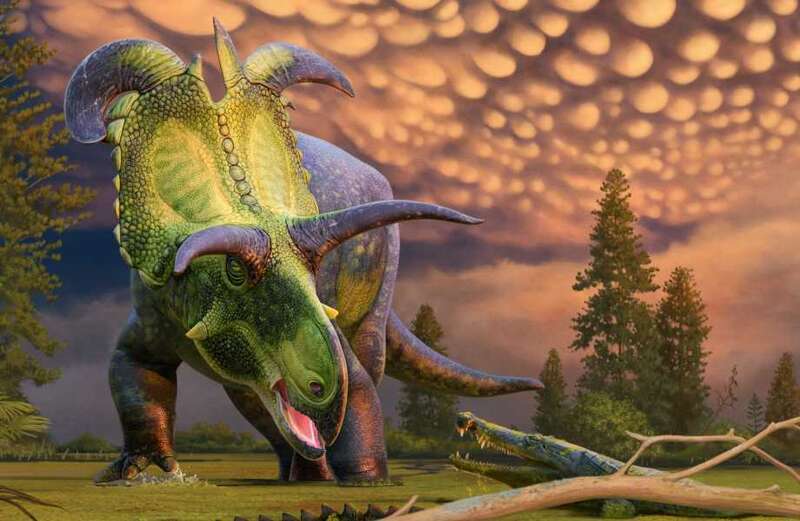A NEW dinosaur with gigantic blade-like horns that walked the Earth almost 80 million years ago has been discovered in the US.
The creature, one of the largest and most ornate dinosaurs ever discovered, had two massive horns on its back frill and two on its head.



Known as the Lokiceratops rangiformis, the plant-eating species lived in swamps and flooded areas across what is now North America.
It was discovered in northern Montana, just a few miles from the US Canada border.
The incredible find was announced today in scientific journal Peer J with a replica of the dinosaur relic set to be unveiled at the Natural History Museum of Utah.
 Man fined £165 after outraging the internet by dying puppy to look like Pikachu
Man fined £165 after outraging the internet by dying puppy to look like Pikachu
Lokiceratops is the cousin to the more well-known Triceratops and was the largest horned dinosaur of its time.
The new species' name translates to "Loki's horned face", named after the blade-wielding Norse god Loki.
The dinosaur skull and partial skeleton was found in Kennedy Coulee prompting a team of experts to carry out detailed analysis on its bones.
It was first discovered in spring 2019 and is now on display at the Museum of Evolution in Maribo, Denmark.
It has turned out to be only the fifth horned dinosaur species ever discovered.
Most of its fellow horned dinosaurs had one on their nose - but not the Lokiceratops.
This beast boasted a distinct, asymmetric spike in the middle of its frill.
The gigantic creature roamed the Earth during the Campanian stage of the late Cretaceous period, 78 million years ago.
It lived in a subtropical coastal plain covered with forests, small lakes and swamps along the east coast of Laramidia.
Island continent Laramidia is now a western part of North America, formed when the continent was divided 100 million years ago.
 Dog who 'always melts hearts' with his smile hopes to find a loving family
Dog who 'always melts hearts' with his smile hopes to find a loving family
Researchers painstakingly reconstructed the bones into 3D models.
They then used known dinosaur skin specimens to replicate it for the sculpture.
Two high quality replicas are housed at the Royal Ontario Museum in Toronto, Ontario, Canada, and the Natural History Museum of Utah, in Salt Lake City, Utah.
Joseph Sertich, a palaeontologist with the Smithsonian Tropical Research Institute and Colorado State University and co-leader of the Lokiceratops study said: "This new dinosaur pushes the envelope on bizarre ceratopsian headgear, sporting the largest frill horns ever seen in a ceratopsian.
"These skull ornaments are one of the keys to unlocking horned dinosaur diversity and demonstrate that evolutionary selection for showy displays contributed to the dizzying richness of Cretaceous ecosystems."
Co-lead author Mark Loewen, palaeontologist at the Natural History Museum of Utah and professor in the geology department at Utah university added: "Previously, palaeontologists thought a maximum of two species of horned dinosaurs could coexist at the same place and time. Incredibly, we have identified five living together at the same time.
"The skull of Lokiceratops rangiformis is dramatically different from the other four animals it lived alongside."







































